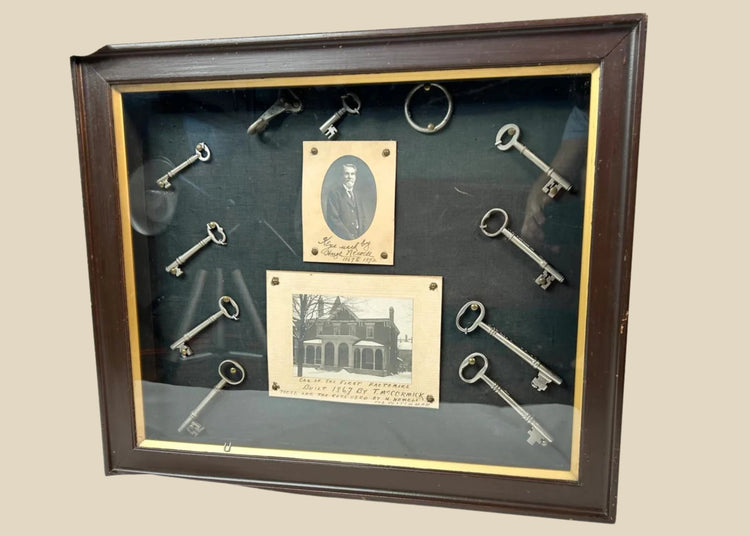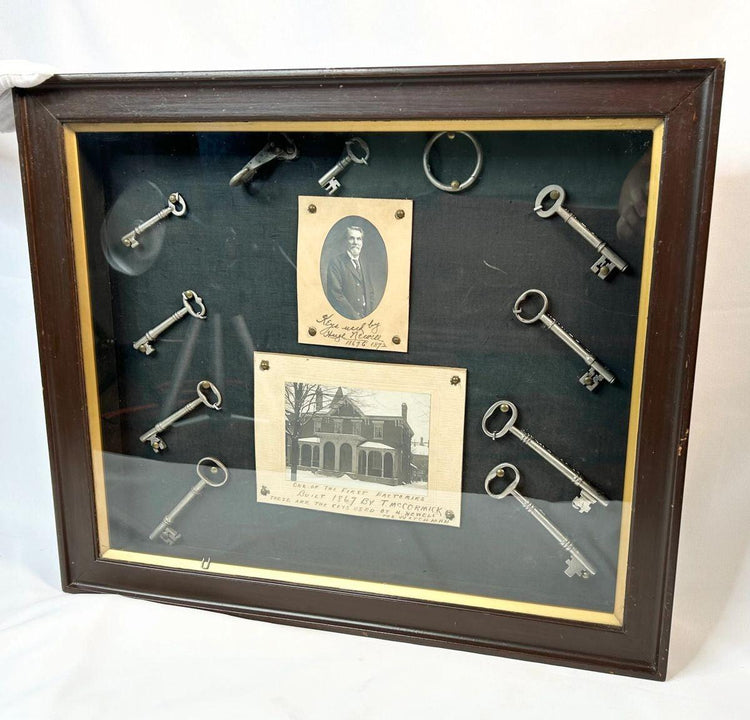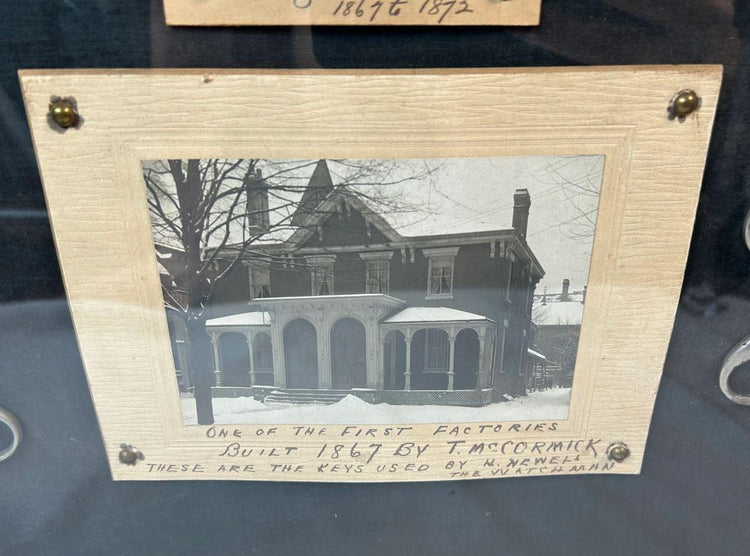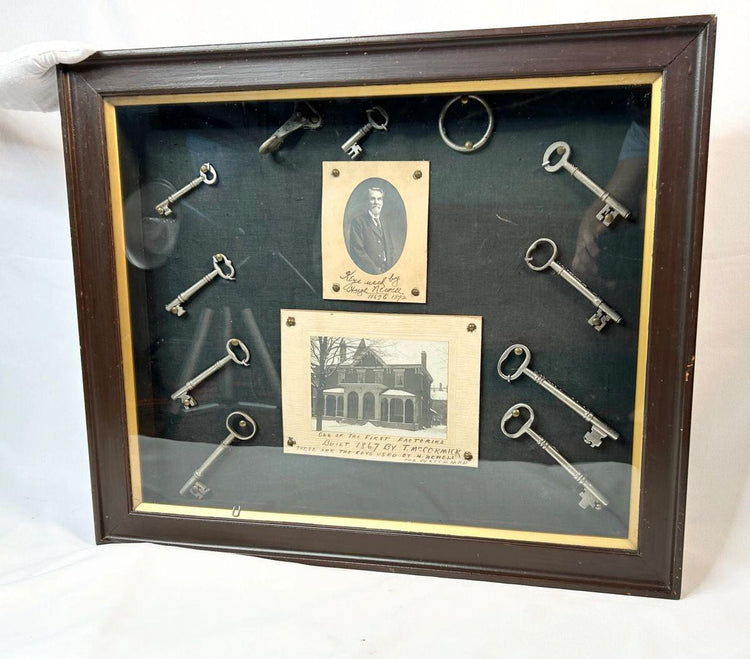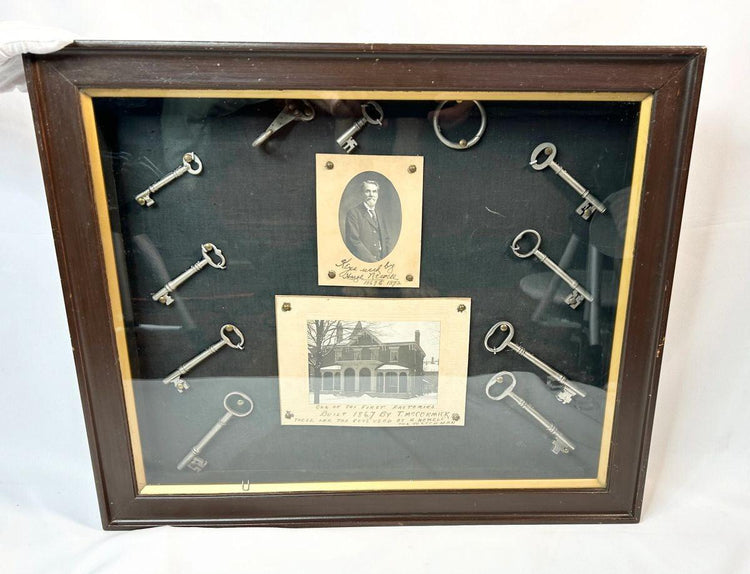T. McCormick Factory Keys | Night Watchman Hugh Newell Provenance | Circa 1867–1872
Description
More
Less
Historical Context & Origin
Region: United States (likely Northeast or Midwest)
Material: Iron keys, glass, wood, early silver gelatin photographs
Period: Late 19th century (circa 1867–1872; frame likely early 20th century)
Description
This exceptional historical assemblage features a set of eleven original 19th-century iron keys attributed to one of the earliest American industrial buildings, constructed in 1867 by T. McCormick. The keys were reportedly used by a night watchman named Hugh Newell between 1869 and 1872, whose photograph is mounted within the display alongside a labeled period image of the original building. The structure, initially a factory, was later converted into a sanitorium for the criminally insane, operating for many years before its eventual closure. Following its decommission, these keys—along with the documentation—were preserved and professionally framed as a historical record. The display is housed in a dark wood shadowbox with glass front, lined in black fabric, and bordered by a giltwood interior trim. The lower photograph bears an original handwritten inscription: “One of the first factories built 1867 by T. McCormick. These are the keys used by H. Newell the watchman.”
Features
- Eleven original mid-19th-century iron keys of varying sizes
- Oval portrait of Hugh Newell with handwritten note (dated 1869–1872)
- Early mounted photograph of the original building in winter
- Shadowbox presentation with brass mounting studs
- Rare provenance linking the object to both industrial and mental health history
Cultural Significance
Artifacts like these are rare survivors of the early industrial and institutional history of the United States. The transformation of the factory into a mental asylum reflects broader 19th-century trends in repurposing large buildings for state health services—especially for psychiatric care. The survival of the keys, along with named documentation and a photograph of the building, offers a uniquely traceable narrative.
Condition
Very good antique condition. Keys show expected age-related oxidation. Photographs and notes have minor foxing and edge wear but remain legible and intact. Frame has minor scuffing but is structurally solid and ready to display.
Dimensions (approximate)
Height: 19.25 in
Width: 23 in
Age
Keys and photos: Circa 1867–1872
Framing: Early–mid 20th century
Learn More
Trace the Development of Skeleton Keys Through History
Description
Historical Context & Origin
Region: United States (likely Northeast or Midwest)
Material: Iron keys, glass, wood, early silver gelatin photographs
Period: Late 19th century (circa 1867–1872; frame likely early 20th century)
Description
This exceptional historical assemblage features a set of eleven original 19th-century iron keys attributed to one of the earliest American industrial buildings, constructed in 1867 by T. McCormick. The keys were reportedly used by a night watchman named Hugh Newell between 1869 and 1872, whose photograph is mounted within the display alongside a labeled period image of the original building. The structure, initially a factory, was later converted into a sanitorium for the criminally insane, operating for many years before its eventual closure. Following its decommission, these keys—along with the documentation—were preserved and professionally framed as a historical record. The display is housed in a dark wood shadowbox with glass front, lined in black fabric, and bordered by a giltwood interior trim. The lower photograph bears an original handwritten inscription: “One of the first factories built 1867 by T. McCormick. These are the keys used by H. Newell the watchman.”
Features
- Eleven original mid-19th-century iron keys of varying sizes
- Oval portrait of Hugh Newell with handwritten note (dated 1869–1872)
- Early mounted photograph of the original building in winter
- Shadowbox presentation with brass mounting studs
- Rare provenance linking the object to both industrial and mental health history
Cultural Significance
Artifacts like these are rare survivors of the early industrial and institutional history of the United States. The transformation of the factory into a mental asylum reflects broader 19th-century trends in repurposing large buildings for state health services—especially for psychiatric care. The survival of the keys, along with named documentation and a photograph of the building, offers a uniquely traceable narrative.
Condition
Very good antique condition. Keys show expected age-related oxidation. Photographs and notes have minor foxing and edge wear but remain legible and intact. Frame has minor scuffing but is structurally solid and ready to display.
Dimensions (approximate)
Height: 19.25 in
Width: 23 in
Age
Keys and photos: Circa 1867–1872
Framing: Early–mid 20th century
Learn More
Trace the Development of Skeleton Keys Through History
You May Also Like




















